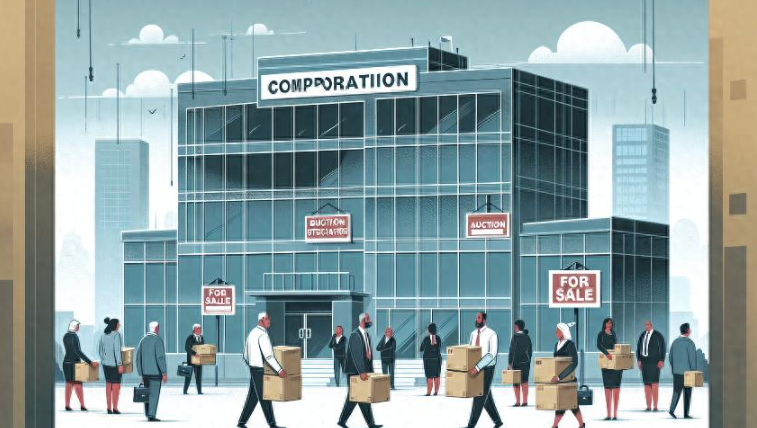Rising Bankruptcy Rates in the U.S.
Advertisements
The landscape of American businesses has become increasingly bleak, particularly as we analyze the troubling trend of rising bankruptcies despite the Federal Reserve's attempts at interest rate reductions. The juxtaposition of declining consumer demand and the stubbornly high costs of goods has created a perfect storm for many companies in distress. What could have been a glimmer of hope for recovery now seems overshadowed by an unchecked wave of corporate failures.
By 2024, projections suggest that more than 686 companies in the United States will have filed for bankruptcy amidst overarching economic challenges—a startling 8% hike from the previous year. This not only marks the highest number of corporate bankruptcies since 2010 but reflects a grim reality that many businesses are struggling to survive in an environment that seemed to promise resurgence. The staggering rise in bankruptcy filings presents an alarming scenario where the economy and consumer behavior present a slippery slope towards further financial turmoil.
These statistics are not merely numbers; they represent livelihoods lost, jobs vanished, and communities shaken to their core. A case in point is Party City, a well-known retailer specializing in party supplies which, after a costly struggle, filed for bankruptcy for the second time in two years. The decision to shutter all 700 stores nationwide speaks volumes about the severity of the current economic climate. This closure is emblematic of a wider trend wherein companies that once thrived are now retracting their operations, signaling a shift that could have long-term repercussions.
The impact of dwindling consumer spending cannot be overstated. As governments have phased out economic stimulus measures that were initially intended to aid recovery during the pandemic, the void left in consumer purchasing power has hit discretionary spending businesses particularly hard. Party City is among numerous firms like Tupperware, Red Lobster, Spirit Airlines, and Avon, all falling prey to the unforgiving nature of the market. This situation starkly illustrates a transitioned American economy where businesses once considered strong or stable find themselves unable to adapt to these new demands.
Gregory Daco, chief economist at EY, articulates the pressure on consumer demand stemming from rising costs. His insights indicate that this pressure is not felt uniformly across the income spectrum; low-income families face disproportionately heavy burdens, while even middle- and upper-income households exhibit heightened caution in spending behaviors. This cautiousness leads to fewer purchases, which creates a detrimental cycle that many businesses cannot escape.

As the Federal Reserve attempts to ease some of this pressure with interest rate reductions, many firms and consumers are hoping for relief. However, economic forecasts remain cautious, projecting only a further 50 basis points cut by 2025. In understanding these monetary policy decisions, it is essential to recognize how they directly tie into business performance and overall economic health. There is a palpable tension between the need for corporate stability and the risk of inflationary consequences that could ensue from aggressive easing policies.
The financial environment is complicated by the disparity between corporate debt and the government bond yields, with riskier corporate bonds currently yielding lower premiums than historical averages. This indicates an underlying instability within corporate America that is not entirely rational, presenting a mixed bag of challenges that necessitate careful monitoring.
The surge in bankruptcies correlating with the number of companies seeking out-of-court restructurings is glaring. This is crucial evidence of a systemic issue where firms are struggling to stay afloat. Such restructurings often serve as a last resort to mitigate the impacts of underlying operational difficulties, which raises the question of long-term survivability for these entities. Despite their attempts at proactive measures, many find themselves ultimately reverting back to bankruptcy as overwhelming debts oppress any hope of rejuvenation.
Reflecting on the trend of the past few years, we observe a stark contrast in corporate behavior. From 2021 to 2022, only 777 bankruptcy filings were recorded—an anomaly attributed primarily to the Fed's low-interest rate strategies. Yet, as we enter 2023 and beyond, projections indicate a return to troubling figures, which have now exceeded even the worst predictions.
Just to highlight the alarming increases, it’s imperative to note that among last year's bankrupt entities, approximately 30 companies faced the stark reality of harboring debts exceeding $1 billion at the time they filed for bankruptcy. This statistic emphasizes not only the magnitude of the financial turmoil but also serves as a reflection of a conglomerate sector stuck in a cycle of excessive leverage.
Strategies around debt management, cleverly packaged and marketed as solutions to avoid court protection, are proliferating within the corporate landscape. Joshua Clark from Fitch Ratings has noted this trend, pointing out that the increasing portion of corporate defaults resulting from these packaged solutions underscores an urgent need for companies to rethink their financial strategies in light of unyielding market conditions. As we move forward into 2024, the potential for this troubling trend to continue remains overwhelmingly high.
Debt management—or perhaps more accurately, mismanagement—risks creating more significant challenges for lenders. What starts as an attempt to stave off bankruptcy may lead to an accumulation of further liabilities, ultimately clouding the financial prospects of those entities that sought to restructure their obligations. In effect, they may find themselves both locked into debt cycles and insufficient operational capacities, thus accentuating the endless loop of corporate instability.
The pattern of increasing corporate bankruptcies raises essential questions about the resilience of both businesses and the broader economic structure. As we inch closer to a new fiscal narrative, marked by adaptation, innovation, and prudent financial oversight, there remains an urgent necessity for stakeholders across the spectrum—be it corporations, regulators, or consumers—to understand the implications of these trends. We must brace ourselves, learning from these turbulent winds, for clearer skies may be yet a far-off reality.
Post Comment